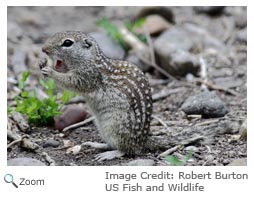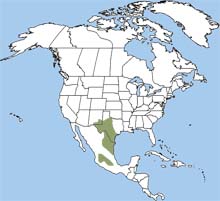Characteristics
 The Mexican ground squirrel is brown with nine rows of squarish white spots on its back. It has a white to cream belly; a long, flattened, somewhat bushy tail; a white circle of fur around its eyes and small rounded ears. It is 11 to 15 inches in length. Males are larger than females. The Mexican ground squirrel is brown with nine rows of squarish white spots on its back. It has a white to cream belly; a long, flattened, somewhat bushy tail; a white circle of fur around its eyes and small rounded ears. It is 11 to 15 inches in length. Males are larger than females.
Range
 The Mexican ground squirrel can be found from Northern Mexico north along the Gulf coast of Texas and into western and central Texas and southeastern New Mexico. The Mexican ground squirrel can be found from Northern Mexico north along the Gulf coast of Texas and into western and central Texas and southeastern New Mexico.
Habitat
The Mexican ground squirrel lives in flat, brushy or grassy areas and usually prefers areas with gravelly or sandy soil. It is often found in sandy and mesquite areas of savannas.
|
|
Diet
The Mexican ground squirrel is omnivorous and feeds during the day. Its diet includes seeds, nuts, grains, roots, bulbs, plant stems, leaves, mice, insects and eggs. It often stores seeds, grains and nuts in its cheeks pouches and takes them back to its den to eat later. In the spring most of its diet is plant matter. In the summer it eats insects. It also eats carrion and is often seen eating roadkill on the highway.
Life Cycle
Breeding season is in March and early April. The gestation period is 23 to 28 days. The female will prepare a nesting chamber in her burrow and line it with mesquite and grass. She gives birth to one to ten young, although the average litter size is five. The young are toothless, naked and blind at birth. They will stay with their mother for about three months.
Behavior
Except for breeding season and when raising young, the Mexican ground squirrel is a solitary creature. While it is solitary, it may live in a colony burrow system. Each squirrel will have more than one burrow and each burrow will have two entrances. The entrances are difficult to locate as they are unmarked by dirt piles. The Mexican ground squirrel may hibernate in the northern part of its range.
|